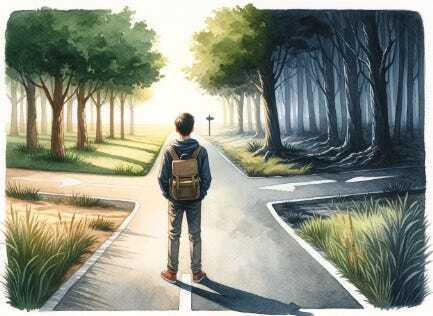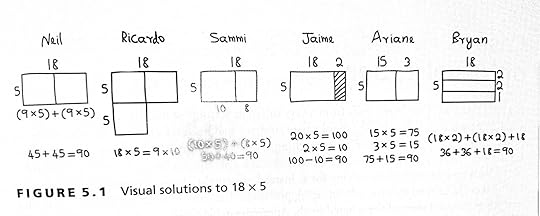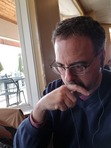Cultivating Student Curiosity, Part Two

(This is the second part of a topic I started here.)
Why it Matters
"It's on the strength of observation and reflection that one finds a way. So we must dig and delve unceasingly."
—Claude Monet (Monet by Himself: Paintings, Drawings, Pastels, Letters)
If repetitive work is already being divided up between automation and offshoring, and information-processing is increasingly being delivered by AI, then the good jobs of tomorrow (if not later today) are going to be things that demand creativity. This is something people were saying long before the advent of ChatGPT, and it’s only becoming more obvious.
But do we know what we mean when we say, “creativity?” Some people might think the word refers only to the arts. Are the good jobs of the future really going to be focused on writing poetry and painting pictures? Interpretive dance?
Boy, wouldn’t it be great if I could say “YES!”
Scenes from a Broken Hand is a reader-supported publication. To receive new posts and support my work, consider becoming a free or paid subscriber.
But no, creativity is not limited to making formal pieces of art. It’s more a quality of thought—a way of approaching problems and seeing solutions. As such, it can play a role in any aspect of life or work.
This is why we have phrases like, “creative accounting.”
Okay, maybe not a great example.
Sir Ken Robinson defines creativity as, “the process of having original ideas,” and he focuses on the importance of the process more than the product or output.
“Original ideas” means that the thinking process and the end-product are unique expressions of an individual perspective. It doesn’t have to mean that the elements that contributed have to be new and unheard of. Creativity doesn’t require “something from nothing.” It’s more like, “something new made from old things.” The world is the world—creative people draw upon the same, existing raw materials that everyone else has available to them. They just see them differently and process them differently, putting existing things or ideas together in new and different ways.
Sir Ken says, “if you’re a human being, it comes with the kit.” I like that. It means our job as educators is not to teach creativity or somehow make it happen (again, forming something out of nothing). It is, instead, our job to cultivate an existing, inherent quality and let it happen. Thinking back to my first post, how wildly different do you think the children’s depictions of houses might have been before they had been in a conforming environment where they were told, even if only subtly and accidentally, that there was only one “right” way to do it? I don’t think we have to teach children how to think individually and idiosyncratically; we have to teach ourselves how to stop telling them how to think “properly.”
How can we support creativity as a thought process and as an everyday part of our curriculum, and not limit it to art class or cut-and-color projects that are “fun” add-ons?
Here are a few ideas.
Make Room for IdeasIf curriculum is simply a list of things that need to be remembered and recited, or a list of skills that need to be practiced and demonstrated, all of it simply for its own sake, there is little room for creativity—for the teacher or for the student. The thing exists for itself, and is simply a series of compliance tasks: do it because authorities told you to do it, and you’ll get in trouble if you don’t do it. That mindset certainly moves us all in the direction of “there’s one right way.”
If curriculum is designed around a set of big ideas or big questions, however, there is a lot of room for creativity in both instruction and in learning. There can be a lot more cognitive play and exploration allowed in the pursuit of knowledge (not that the approach in the paragraph above precludes creativity; it just may not need or value it).
The Understanding by Design framework developed by Wiggins and McTighe tries to help teachers design curriculum units through “backwards design,” with the end-goal of a big idea or question in mind. Knowing what big concept you want students to understand, or what question you want students to grapple with, can inform what you decide to teach, how you decide to teach it, and what an assessment of learning might look like. It helps teachers break out of the checklist or “one damned thing after another” approach, where Topic X is being taught mostly (or completely) because it follows Topic W in the textbook or pacing plan.
Some of the UbD work is based on H. Lynn Erickson’s idea of concept-based curriculum, which puts facts and topics in service of ideas. Yes, you can gather a bunch of facts together in a chapter or a unit related to westward expansion in the United States, and call it “Westward Expansion” or “Manifest Destiny,” but all you’ve done is build a box for discrete and disconnected facts. It’s an organizing principle, but isn’t necessarily a structure that helps students assemble facts into a schema or an overarching concept that would be meaningful and powerful to them.
The same unit (or even a whole course) could built around a core concept, like, “People migrate to find new opportunities or escape repression.” Or, to take a more critical stance, you could write: “When people migrate to find new opportunities, their needs often clash with those of the people already living in those lands.”
If that was how your unit or course were framed, you would probably approach content in a very different way, to help students look at discrete periods of history and connect facts to ideas. You might leave certain details out, because they may not be as important or relevant to the building of that concept. You might want to bring other material in. You might want to take a critical stance towards the concept and have students debate against it, to see where the evidence really leads them.
Another approach would be to back off of definitive statements entirely, and simply pose a tough question, like, “How did the idea of Manifest Destiny change America’s conception of itself and the way it behaved in the world?” You could even use a big, gnarly question to frame the entire course. Imagine teaching an American history course framed and structured around a question like this: “Is a ‘new world’ ever really possible?”
Make Room for WonderWhen starting a new topic, teachers sometimes use a K-W-L chart (for Know, Want to Know, and Learn), to get students to think about the topic ahead of them (and then to review what they’ve learned at the end). I’ve never been a huge fan of them, because I’ve had students who would answer all three questions the same way (What do you know about this topic already? Nothing. What do you want to know? Nothing. What have you learned now that we’re done? Nothing).
But I recently ran across a different way of structuring this kind of graphic organizer, which I like a lot: See/Notice/Wonder. It doesn’t assume any prior knowledge and it doesn’t presume that students are already engaged and curious . It focuses on the here-and-now in an interesting way, by asking: What did you see? What did you notice? What do you wonder?
A set of questions like this can help students engage more deeply and thoughtfully in what they’re doing. I love the distinction between seeing and noticing—the surface level and the deeper level. And then it asks students to ponder and wonder and ask a question—not a general one, but something specific to what they’ve just noticed: “I see that the leaf has veins in it. I noticed that they work just like how our own veins and arteries work. I wonder if there’s some connection between plants and animals that we haven’t thought about before.”
Noticing is the doorway to wonder, as we see in this quote: “Very often students are searching for what is correct in the view of the teacher. Focusing their attention on their own and each other’s close observing is a reorientation for them.”
If creativity means putting things and ideas together in novel ways, we need to encourage students to engage deeply with those things and ideas, and give them time to manipulate and test-drive and play with them in unrestricted, undefined ways. This is exactly the kind of thing I used to talk about in my workshops on “Teaching for the stretch.”
Make Room for Unique ResponsesSome questions have room for more than one “correct” answer. Some don’t. How much freedom do we give students to think uniquely about questions and challenges and find their own pathways to solutions?
Recall the story I told in an earlier post about my younger son being taught a different approach to solving multi-digit multiplication problems, and how difficult it was to change the culture and mindset from “this is THE way it’s done.” Author and math educator, Jo Boaler, does wonderful work in this area, showing how important it can be to let students mess around with numbers and construct their own pathways to solutions. Messing around—getting your hands dirty, as it were—is how you really get to know a thing, and real understanding of numbers and how they work, what we call “number sense,” is sorely lacking in our country. Which is why we have stories like the one about A&W Restaurants, and why the launch of their new, 1/3-pound hamburger was a flop.
As Boaler says, “real problems often require the choice and adaptation of methods that students have often never learned to use or even think about” (Mathematical Mindsets, p. 45). Knowing an algorithm is great when you get to the point of needing to perform a mathematical operation. But a lot real-world problem solving requires critical and creative thinking to get us to that final point of knowing what operations to perform.
Here’s an example of an activity Boaler led for adult educators, which can be both engaging and powerful for children (Mathematical Mindsets, p. 59). She simply asked them to think about different ways to visualize and represent 18 x 5:

Is there a simple, algorithmic way to work out the problem? Of course. But having done so, do you really understand what’s happening with those numbers? Fluency and speed matter a great deal, but so does conceptual understanding, and we become creative problem-solvers by learning how to come at problems from a number of different angles and directions.
I’ve been thinking about this a lot, lately, because I’ve been watching old episodes of a British game show called “Countdown” (actually, I’ve been watching the comedy version of it, called “8 out of 10 Cats Does Countdown”), one element of which requires contestants to put together six randomly selected, one-or-two-digit numbers to get to a randomly generated, three-digit number. They can only use each number once, but they can use any operations they choose. It’s amazing to watch these actors and comedians race the clock (they only have 30 seconds) to get to the number. Most of them get there, or close, most of the time. They rarely do it in exactly the same way as each other.
That’s a level of comfort with numbers that I have never had, and for which my K-12 math education did not think to prepare me.
Why it MattersLet’s return to where we started. We live in a complex world which is becoming more complicated and strange every day. If today’s students are going to thrive in tomorrow’s world, the reality of which we can only make guesses about today, we need to prepare them to use their skills and knowledge in creative ways—putting old things together in new and oddball ways to meet the new challenges they’ll be facing.
One of my favorite examples of this kind of thinking comes from the 1955 film, “The Dam Busters,” the true story of the scientists and pilots who figured out how to build and deploy a bomb that could bounce along the surface of a reservoir and then sink at exactly the right moment along the wall of the dam in order to blow it up. One of the many challenges facing the team is that, for the bouncing bomb to work, it has to be dropped at a particular altitude and speed. But the altitude is so low—only 150 feet off the surface—that the plane’s instruments won’t work. And they’ll flying in the dead of night, where they’ll barely be able to see anything. How on earth can they figure out a precise altitude measurement in a situation like that?
This is how:
Scenes from a Broken Hand
- Andrew Ordover's profile
- 44 followers



